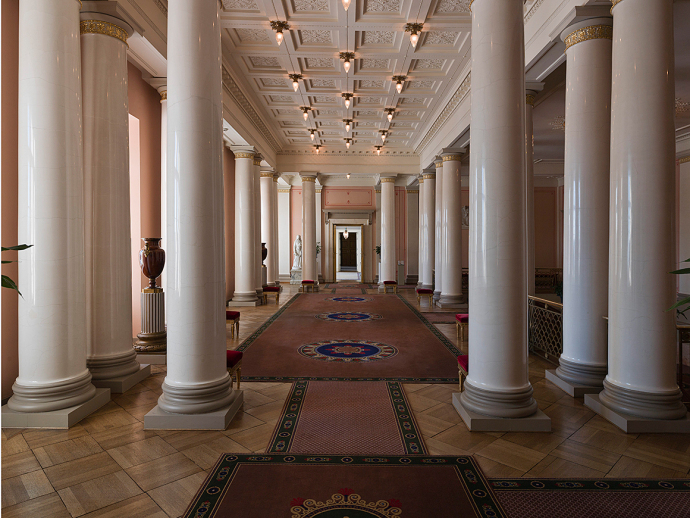The Vestibule
The Vestibule is a prime example of Norwegian Classicist architecture. The Upper Vestibule is where the Lord Chamberlain greets guests arriving for banquets and the recipients of honours before their audience with the King.
The placing of the Vestibule and the main staircase in the centre of the Palace determined the city planning of Oslo. The main thoroughfare, Karl Johans gate, was built in the 1830s to link the city centre with the king’s residence. Karl Johans gate is one of Oslo’s principal axes and the only promenade of European dimensions in Norway.
Architect Hans Fredrik von Linstow considered it essential to impress the visitor on arrival:
“Since all visitors enter by way of the Vestibule, and first impressions are very important, I have sought to give the Vestibule and the main flight of steps an imposing character.”
Design and decoration
The main staircase brings the visitor via a landing to the Upper Vestibule, the piano nobile, where the reception rooms are located. One wall is occupied by the five tall windows behind the columns of the front façade, the central one being the door onto the Palace balcony. Thus after mounting the stairs the visitor is greeted with a view of Karl Johans gate leading towards the Parliament Building.
The columns
The upper vestibule is rimmed with 20 columns in stucco marble. In the original plan they were to be carved out of white marble from Bergen, and the Storting allocated funds for this purpose in 1836. Quarrying was begun, but during one of his journeys abroad Linstow became convinced that stucco marble would be a better material since it permitted a greater choice of colours. He proposed stucco marble in 1839, and again in 1840 and 1842, when his idea was finally accepted by the Palace Building Committee.
Decoration
In accordance with Linstow’s original design, the walls of the Upper Vestibule are distempered in pale pink, with palmettes and panels outlined in vermilion, while the columns are a creamy white. The coffered ceiling has been distempered in white.
The original staircase was replaced during the renovation in 1906-1907. Today the stairs and floor of the Vestibule are covered by specially designed carpets. Their ground colour reflects the deep brownish red of the staircase and banisters, and the patterns and motifs are based on Linstow’s detailed designs, with their classical ornamentation.
The Upper Vestibule contains a number of sculptures and two plaster reliefs, the latter depicting important events connected with the building of the Palace:
Reliefs
- King Carl XIV Johan laying the foundation stone on 1 October 1825
Commissioned by King Oscar II and sculpted by Stephan Sinding in 1879. - King Oscar II unveils the monument to King Carl XIV Johan 7 September 1875
Commissioned by King Oscar II and sculpted by Mathias Skeibrok in 1882. The monument referred to is the bronze statue of Carl XIV Johan on the Palace Square. It was made by Brynjulf Bergslien and cast in Copenhagen.
Sculptures
- Bust of King Oscar I
Oscar I was the first king to make use of the Royal Palace, and his bust has been placed in the niche above the landing. Dated 1882, it was made by Christen Daae Magelssen and purchased by King Oscar II. - Hylas, Herakles’ yndling / Hylas, the beloved of Hercules
Sculpted in marble by Stephan Sinding and completed in Rome in 1882. The sculpture was part of the Norwegian people’s gift to King Oscar II and Queen Sophie on the occasion of their silver wedding anniversary in 1882. - Adam og Eva før syndefallet / Adam and Eve before the Fall
The sculpture was made by the Danish sculptor Jens Adolf Jerichau. It was given by Danish landowners to Princess Alexandra of Denmark on the occasion of her wedding to Albert Edward VII, then Prince of Wales, on 10 March 1863. It stood for many years in Marlborough House, London. - Badende piker / Young girls bathing
This sculpture was also made by Jerichau, in 1868, and was purchased by Princess Alexandra in the same year. It had previously stood in Sandringham House, England, and was brought to Norway as part of an inheritance in 1925. - Ruth
The sculpture depicts the Bible story of Ruth gathering corn, and was completed by the Norwegian sculptor Carl Ludwig Jacobsen in 1885. It, too, was part of the people’s gift to King Oscar II and Queen Sophie on their silver wedding anniversary in 1882.
Restoration
During the restoration work in the 1990s an examination was carried out to determine the original colours of the vestibule walls, and the results were compared with the written documentation in the palace archives. These efforts revealed that during the previous 150 years the room had undergone two main phases of decoration:
- The first phase: 1849-1906. The walls were distempered in pale pink and the panels picked out in vermilion. The pink background accentuated the creamy white of the columns.
- The second phase: 1907-1997. In accordance with the style of the time the walls in the Upper and the Lower Vestibule were painted the same creamy white as the stucco marble columns.
During the most recent renovation of the Vestibule the question arose of whether to keep the 90-year-old colours, which were from the same period as the staircase and banisters, or to return to the original hues. In the end it was decided to repaint in the colours used in Linstow’s scheme, and in addition to gild the capitals of the columns, as Linstow originally proposed.
The stairwell and passage of the Lower Vestibule, were repainted in their original colours in 1971, during the reign of King Olav V.

 Større bilde
Større bilde

